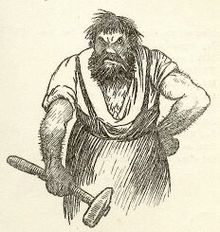Metalsmith

A metalsmith, often shortened to smith, is a person involved in making metal objects. In contemporary use a metalsmith is a person who uses metal as a material, uses traditional metalsmithing techniques (though not necessarily the material), whose work thematically relates to the practice or history of the practice, or who engages in any number metal related activities.
Etymology of smith

The word smith is cognate with the somewhat archaic English word, "smite", meaning "to hit" or "to strike". Originally, smiths practiced their crafts by forming metal with hammer blows.
As an English suffix, -smith connotes a meaning of specialized craftsmen — for example, wordsmith and tunesmith are nouns synonymous with writer or songwriter, respectively.
History of Metalsmiths
In pre-industrialized times, smiths held high or special social standing since they supplied the metal tools needed for farming (especially the plough) and warfare. This was especially true in some West African cultures.
Types of smiths
Types of smiths include: [1]
- a blacksmith works with iron and steel; (this is what is usually meant when referring just to "Smith")
- an arrowsmith forges arrow heads;
- a bladesmith forges knives, swords, and other blades;
- a coppersmith, or brownsmith, works with copper;
- a fendersmith makes and repairs the metal fender before fireplaces, protecting rugs and furniture in mansions and fine estates, and frequently cares for the fires as well;
- a pewtersmith works with pewter;
- a silversmith, or brightsmith, works with silver; [2]
- a tinsmith, tinner, or tinker works with light metal (such as tinware) and can refer to someone who deals in tinware;
- a swordsmith is a bladesmith who forges only swords;
- a whitesmith works with white metal (tin) and can refer to someone who polishes or finishes the metal rather than forging it.
Artisans and craftpeople
The ancient traditional tool of the smith is a forge or smithy, which is a furnace designed to allow compressed air (through a bellows) to superheat the inside, allowing for efficient melting, soldering and annealing of metals. Today, this tool is still widely used by blacksmiths as it was traditionally.
The term, metalsmith, often refers to artisans and craftpersons who practice their craft in many different metals, including gold, copper and silver. Jewelers often refer to their craft as metalsmithing, and many universities offer degree programs in metalsmithing, jewelry, enameling and blacksmithing under the auspices of their fine arts programs. [3]
Machinists
Machinists are metalsmiths who produce high-precision parts and tools. The most advanced of these tools, CNC machines, are computer controlled and largely automated.
References
- ^ John Fuller, Sr., Art of Coppersmithing, Astragal Press, 1993 (reprint of original edition, 1894) ISBN 1879335379
- ^ Silversmithing, Rupert Finegold and William Seitz, Krause Publications, 1983, ISBN 0801972329
- ^ Tim McCreight, Jewelry: Fundamentals of Metalsmithing, Hand Books Press, 1997, ISBN 1880140292
External links
